- Author Rachel Wainwright [email protected].
- Public 2023-12-15 07:39.
- Last modified 2025-11-02 20:14.
Gabapentin
Gabapentin: instructions for use and reviews
- 1. Release form and composition
- 2. Pharmacological properties
- 3. Indications for use
- 4. Contraindications
- 5. Method of application and dosage
- 6. Side effects
- 7. Overdose
- 8. Special instructions
- 9. Application during pregnancy and lactation
- 10. Use in childhood
- 11. In case of impaired renal function
- 12. Drug interactions
- 13. Analogs
- 14. Terms and conditions of storage
- 15. Terms of dispensing from pharmacies
- 16. Reviews
- 17. Price in pharmacies
Latin name: Gabapentin
ATX code: N03AX12
Active ingredient: gabapentin (gabapentin)
Producer: PIK-PHARMA (Russia), Kanonpharma production, CJSC (Russia), Aurobindo Pharma (India)
Description and photo update: 2019-02-09
Prices in pharmacies: from 368 rubles.
Buy

Gabapentin is an analgesic and anticonvulsant drug.
Release form and composition
The drug is available in the form of capsules: hard gelatinous, white, size No. 0; content - powder, white or white with a yellowish tinge color (10 pcs. in blister packs, in a cardboard box 5 packs; 15 pcs. in blister packs, in a cardboard box 3 packs; 50 pcs. or 100 pcs. in polymer cans, in a cardboard box 1 can and instructions for the use of Gabapentin).
Composition of 1 capsule:
- active substance: gabapentin - 300 mg;
- auxiliary components: sodium carboxymethyl starch type A, microcrystalline cellulose, calcium stearate;
- capsule shell: titanium dioxide, gelatin.
Pharmacological properties
Pharmacodynamics
Structurally, gabapentin is similar to the neurotransmitter GABA (gamma-aminobutyric acid), but its mechanism of action differs from other drugs that interact with GABA receptors (valproic acid, barbiturates, benzodiazepines, inhibitors of GABA uptake, inhibitors of GABA transaminase and GABA agonists, agonists forms of GABA).
Gabapentin has no GABA-ergic properties and does not affect the capture and metabolism of GABA. According to preliminary studies, the substance binds to the α 2 -δ-subunit of voltage-dependent calcium channels and reduces the flow of calcium ions, which plays an important role in the development of neuropathic pain.
Other mechanisms of action for neuropathic pain include:
- increased synthesis of GABA;
- decrease in glutamate-dependent neuronal death;
- suppression of the release of neurotransmitters of the monoamine group.
At clinically significant concentrations, gabapentin does not bind to receptors for other common drugs or neurotransmitters, including receptors for GABA B, GABA A, glycine, glutamate, N-methyl-D-aspartate, or benzodiazepine receptors.
Gabapentin, unlike carbamazepine and phenytoin, does not interact with sodium channels in vitro. During drug therapy, in some in vitro tests, there is a partial weakening of the effects of the glutamate receptor agonist N-methyl-D-aspartate, but only at a concentration> 100 μmol, which is not achieved in vivo. Gabapentin slightly reduces the release of monoamine neurotransmitters.
Pharmacokinetics
The bioavailability of gabapentin is not dose-dependent and decreases with increasing dose. C max (maximum concentration of the substance) of gabapentin in plasma after oral dosing is achieved in 2-3 hours. Absolute bioavailability is approximately 60%. Food, including those containing a large amount of fats, does not affect the pharmacokinetic parameters.
Removal of matter from plasma is best described using a linear model. T 1/2 (half-life) from plasma on average is 5-7 hours and does not depend on the dose. With repeated use, the pharmacokinetic parameters do not change. The value of equilibrium plasma concentrations can be predicted based on the results of a single dose of the drug.
Gabapentin practically does not bind to plasma proteins (<3%), Vd (volume of distribution) is 57.7 liters. It does not undergo metabolism, it is excreted exclusively unchanged by the kidneys.
The substance does not induce mixed liver oxidative enzymes, which are involved in the metabolism of drugs. In elderly patients and against the background of impaired renal function, the clearance of gabapentin from plasma decreases. The rate constant of elimination, renal clearance, and plasma clearance are directly proportional to creatinine clearance. In hemodialysis, gabapentin is removed from the plasma. Patients with impaired renal function and patients receiving hemodialysis treatment are recommended to carry out dose adjustments.
Indications for use
Gabapentin is used in children over 12 years of age and in adults as the only or additional agent for partial seizures without or with secondary generalization.
It is also prescribed for neuropathic pain (adults over 18 years old only).
Contraindications
Gabapentin is contraindicated in patients under the age of 12 years (with partial seizures), children and adolescents under 18 years of age (when prescribed as an analgesic) and patients with increased individual sensitivity to the components of the drug.
The drug is used with caution in patients with renal insufficiency.
During pregnancy, Gabapentin can be taken only in cases where the intended benefit is greater than the possible harm. There are no data to support the safety and effectiveness of therapy. During lactation, the drug is contraindicated.
Gabapentin, instructions for use: method and dosage
Gabapentin capsules are taken orally, regardless of food, washed down with plenty of liquid. The capsule should be swallowed whole without chewing.
Dose reduction, drug withdrawal or its replacement with an alternative drug should be carried out gradually, over at least one week.
For partial seizures, the effective dose is 900-2400 mg per day. Treatment can be started immediately with 300 mg three times a day or gradually increase the dose to 900 mg per day according to the following scheme: the first day - 300 mg once a day, the second day - 300 mg twice a day, the third day - 300 mg three times a day. In the future, the dose of Gabapentin can be increased to a maximum, which is 3600 mg per day in three divided doses. When using the drug three times a day, the interval between doses should not exceed 12 hours, otherwise seizures may resume.
For neuropathic pain, the starting dose is 900 mg daily in three divided doses. It is also acceptable to gradually increase the dose during the first three days according to the scheme described above. If necessary, the dose is increased to a maximum of 3600 mg per day in three divided doses.
In patients with renal insufficiency, the dose of Gabapentin is reduced taking into account the CC (creatinine clearance):
- CC> 80 - 900-2400 mg per day;
- CC 50-79 - 600-1200 mg per day;
- CC 30-49 - 300-600 mg per day;
- KK 15-29 - 300 mg per day or 300 mg per day every other day;
- CC <15 - 300 mg per day every other day.
Patients on hemodialysis who have not previously taken Gabapentin are prescribed the drug in a saturating dose of 300-400 mg. Thereafter, it is recommended to take 200-300 mg of gabapentin every 4 hours of hemodialysis.
Side effects
Possible side effects when treating partial seizures:
- digestive system: dental diseases, dry mouth or pharynx, gingivitis, increased appetite, dyspeptic disorders, anorexia, nausea and / or vomiting, flatulence, constipation or diarrhea, abdominal pain;
- cardiovascular system: increased blood pressure or symptoms of vasodilation;
- respiratory system: rhinitis, pharyngitis, cough, pneumonia;
- lymphatic system and hematopoietic system: purpura, a decrease in the number of leukocytes;
- nervous system: insomnia or drowsiness, dizziness, nervousness, amnesia, confusion, depression, nystagmus, tremor, hyperkinesis, paresthesia, ataxia, impaired coordination, emotional lability, impaired thinking, hostility, anxiety, muscle twitching, dysarthria, weakening, strengthening, or lack of reflexes;
- sense organs: visual impairment, diplopia, amblyopia;
- musculoskeletal system: myalgia, fractures, arthralgia;
- genitourinary system: impotence, urinary tract infection;
- skin and subcutaneous fat: itching, skin rash, abrasions, acne;
- other reactions: headache, general malaise, back pain, asthenia, fatigue, facial edema, peripheral edema, weight gain, viral infection, fever.
Possible side effects of neuropathic pain treatment:
- digestive system: dry mouth, nausea and vomiting, dyspeptic disorders, flatulence, constipation or diarrhea, abdominal pain;
- respiratory system: pharyngitis, shortness of breath;
- nervous system: drowsiness, dizziness, amnesia, confusion, tremor, hypesthesia, ataxia, impaired thinking and gait;
- sense organs: amblyopia;
- skin and subcutaneous fat: skin rash;
- other reactions: headache, back pain, asthenia, peripheral edema, pain of various localization, weight gain, infection, flu-like syndrome, accidental injury.
Overdose
The main symptoms: diarrhea, double vision, dizziness, drowsiness, speech impairment, lethargy.
Therapy: gastric lavage, intake of activated charcoal, symptomatic treatment. In severe renal failure, hemodialysis may be considered.
special instructions
In patients with partial seizures, abrupt withdrawal of antiepileptic drugs is not recommended, since seizures may develop with a single cessation of therapy.
Gabapentin is ineffective in the absence of epilepsy.
With simultaneous use with morphine, an increase in the dose of gabapentin may be required. It is also necessary to carefully monitor patients for the development of drowsiness. If signs of drowsiness appear, the dose of morphine or gabapentin should be adequately reduced.
When the drug was used together with other anticonvulsants, false-positive results were observed in the determination of urine protein using Ames N-Multistix SG test strips (it is recommended to use more specific methods, for example, the sulfosalicylic acid precipitation method).
Influence on the ability to drive vehicles and complex mechanisms
During the treatment with Gabapentin, it is necessary to abandon driving vehicles and performing other work that requires a high concentration of attention and speed of reactions.
Application during pregnancy and lactation
- pregnancy: Gabapentin can only be used if the intended benefit is greater than the potential harm;
- lactation period: therapy is contraindicated.
Pediatric use
Contraindication:
- up to 12 years: with partial seizures;
- up to 18 years of age: with neuropathic pain.
With impaired renal function
In renal failure, Gabapentin should be used with caution.
If renal function is impaired and in patients receiving hemodialysis treatment, dose adjustment is recommended.
Drug interactions
When taken together with morphine, the incidence of side effects of morphine did not increase.
There was no clinically significant interaction of Gabapentin with phenytoin, carbamazepine, phenobarbital, valproic acid, oral contraceptives with ethinyl estradiol and / or norethisterone, as well as other anticonvulsants, cimetidine and probenecid.
Magnesium and aluminum-containing antacids reduce the bioavailability of Gabapentin by about 20%, so the interval between taking these drugs should be at least 2 hours.
Analogs
The analogues of Gabapentin are: Gabagamma, Gapentek, Konvalis, Katena, Lepsitin, Neurontin, Tebantin, Eplirontin.
Terms and conditions of storage
Store in a dry, dark place, out of reach of children, at a temperature not exceeding 25 ° C.
Shelf life is 2 years.
Terms of dispensing from pharmacies
Dispensed by prescription.
Reviews about Gabapentin
Reviews of Gabapentin indicate its effectiveness, with many reporting the development of severe side effects, including depression and addiction. The cost in comparison with analogs is estimated as affordable, while in some cases it is noted that Gabapentin is inferior to some analogs in terms of effectiveness.
Price for Gabapentin in pharmacies
The approximate price for Gabapentin (50 capsules) is 377-495 rubles.
Gabapentin: prices in online pharmacies
|
Drug name Price Pharmacy |
|
Gabapentin Canon 300mg capsules 50 pcs. 368 RUB Buy |
|
Gabapentin 300 mg capsule 50 pcs. 368 RUB Buy |
|
Gabapentin 300 mg capsule 50 pcs. 395 RUB Buy |
|
Gabapentin 300mg capsules 50 pcs. 443 r Buy |

Anna Kozlova Medical journalist About the author
Education: Rostov State Medical University, specialty "General Medicine".
Information about the drug is generalized, provided for informational purposes only and does not replace the official instructions. Self-medication is hazardous to health!






